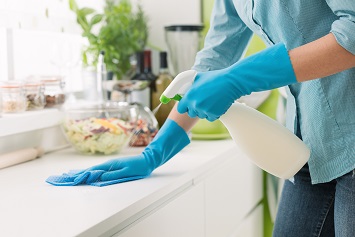The EPA has released a list of 82 registered disinfectant products that have been qualified for use against severe acute respiratory syndrome coronavirus 2 (SARS-CoV-2), the novel coronavirus that causes COVID-19.
Products on the list have qualified for use against COVID-19 through the Agency’s Emerging Viral Pathogen program. This program allows product manufacturers to provide the EPA with data, even in advance of an outbreak, that show their products are effective against harder-to-kill viruses than SARS-CoV-2. It also allows off-label communications intended to inform the public about the utility of these products against the emerging pathogen in the most expeditious manner.
Asymptomatic Carriers
COVID-19 is particularly dangerous because people who carry the virus, which is highly infectious, may show no symptoms and can transmit the virus for up to 24 days. Transmission is most common through droplets expelled from a symptomatic carrier through sneezing or coughing. However, COVID-19 can be transferred from any infected person to surfaces made from a variety of materials—where it can remain viable for hours to days. Cleaning of visibly dirty surfaces followed by disinfection is a best practice to prevent the spread of COVID-19 and other viral respiratory illnesses in businesses, households, healthcare facilities, and community settings.
Disinfecting Enveloped Viruses
Perhaps one of the few encouraging aspects of the COVID-19 outbreak is that the virus is enveloped. Enveloped viruses are the least resistant to inactivation by disinfection. The structure of these viruses includes a lipid envelope, which is easily compromised by most disinfectants. Once the lipid envelope is damaged, the integrity of the virus is compromised, thereby neutralizing its capacity to infect.
EPA’s Guidance
The EPA developed its Emerging Viral Pathogen Guidance in response to concerns about emerging pathogens, an increasing public health concern in the United States and globally. Because the occurrence of emerging viral pathogens is less common and predictable than established pathogens, few, if any, EPA-registered disinfectant product labels specify use against these infectious agents. Also, the pathogens are often unavailable commercially, and standard methods for laboratory testing may not exist.
The guidance was developed and finalized in 2016 to allow for a rapid response in the event of an emerging viral pathogen outbreak. It was triggered for the first time ever for COVID-19 on January 29, 2020. The guidance outlines a voluntary, preapproval process for making emerging viral pathogens claims. In the event of an outbreak, companies with preapproved products can make off-label claims (for example, in technical literature, non-label-related websites and social media) for use against the outbreak virus.
Basic Recommendations
The Centers for Disease Control and Prevention (CDC) has provided many resources to assist healthcare facilities, community sites, businesses, and households in preventing the spread of the virus. One CDC site provides the following recommendations:
- Routinely clean all frequently touched surfaces in the workplace, such as workstations, countertops, and doorknobs, using a detergent or soap and water before disinfection.
- Wear disposable gloves when cleaning and disinfecting surfaces. Gloves should be discarded after each cleaning. If reusable gloves are used, those gloves should be dedicated for cleaning and disinfection of surfaces for COVID-19 and should not be used for other purposes. Consult the manufacturer’s instructions for cleaning and disinfection products used. Clean hands immediately after gloves are removed.
- For disinfection, diluted household bleach solutions, alcohol solutions with at least 70 percent alcohol, and most common EPA-registered household disinfectants should be effective.
- Diluted household bleach solutions can be used if appropriate for the surface. Follow manufacturer’s instructions for application and proper ventilation. Check to ensure the product is not past its expiration date. Never mix household bleach with ammonia or any other cleanser. Unexpired household bleach will be effective against coronaviruses when properly diluted. Prepare a bleach solution by mixing 5 tablespoons (1/3 cup) bleach per gallon of water or 4 teaspoons bleach per quart of water.
The CDC’s COVID-19 guidance specific to certain industries is available here.

